Muphrid, Eta Boötis (η Boo) is a yellow subgiant star located 37.2 light-years away in the northern constellation Boötes (the Herdsman). With an apparent magnitude of 2.680, it is the third brightest star in Boötes, after Arcturus and Izar. Muphrid forms an asterism known as the Kite with other bright stars in the Herdsman constellation.
Star system
Eta Boötis is a binary star system composed of a star of the spectral type G0 IV and an unseen companion. The system is a suspected spectroscopic binary star with an orbital period of 494 days. The close companion is separated by a distance comparable to that between the Sun and Mars.
The companion has never been observed. Speckle interferometry observations in the 1970s, 1980s and 1990s showed no evidence of a second star. However, the 1957 paper that reported the discovery of the binary companion suggested a low-mass orange or red dwarf.
Muphrid has a mass of 1.71 solar masses and a radius 2.672 times that of the Sun. With an effective temperature of 6,100 K, it is 8.89 times more luminous than the Sun. The star spins at 11.8 km/s. It has an estimated age of 2.7 billion years.
Muphrid has just stopped fusing hydrogen in its core and will next evolve into a red giant. Eventually it will eject its outer layers to form a planetary nebula and end its life as a white dwarf.
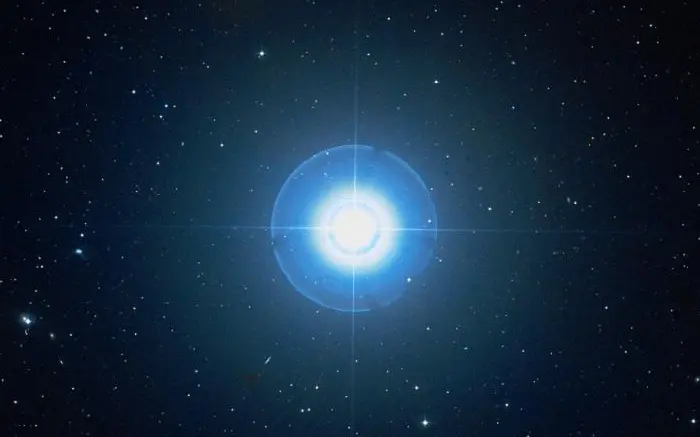
Muphrid (Eta Boötis), image: Wikisky (DSS)
Facts
Eta Boötis has served as a spectral standard for its class since 1943. The star’s spectrum is used as one of the stable anchor points by which other stars are classified.
Muphrid appears close to the red giant Arcturus in the sky. Shining at magnitude -0.05, Arcturus is the brightest star in Boötes and in the northern celestial hemisphere. The two stars do not only appear in the same line of sight when seen from Earth, but also lie at a similar distance from the Sun.
Arcturus is Muphrid’s nearest neighbour. The physical distance between the two stars is only 3.24 light-years. In comparison, the distance from the Sun to its closest neighbour, Proxima Centauri, is 4.2465 light-years.
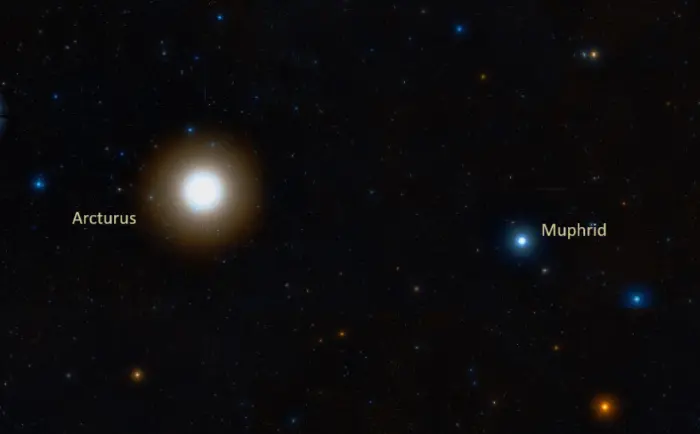
Arcturus and Muphrid, image: Wikisky (DSS)
Seen from a hypothetical planet orbiting Muphrid, Arcturus would shine at magnitude -5.2 and be almost twice as bright as Venus appears from Earth. Muphrid, in turn, would have an apparent magnitude of -2.4 when seen from the Arcturus system. It would appear more than twice as bright as Sirius does from Earth.
Eta Boötis is listed as WDS J13547+1824A in the Washington Double Star Catalog as a component of a double pair. The star catalogued as WDS J13547+1824A is the orange dwarf BD +19 2726. The two stars form a visual pair and BD +19 2726 should not be mistaken for Eta Boötis B. The two components of WDS J13547+1824A are designated Aa and Ab.
Arcturus and Muphrid are part of the Kite, a relatively bright asterism that dominates the constellation Boötes. The Kite is a familiar feature of the northern spring sky. Sometimes called the Ice Cream Cone, the star pattern is formed by the brightest stars of Boötes. The main Kite pattern is formed by Arcturus, Izar, Delta Boötis, Nekkar, Seginus, and Rho Boötis, while Muphrid, Zeta, Tau and Upsilon Boötis form the tether and tail. The asterism can be spotted from areas without too much light pollution.
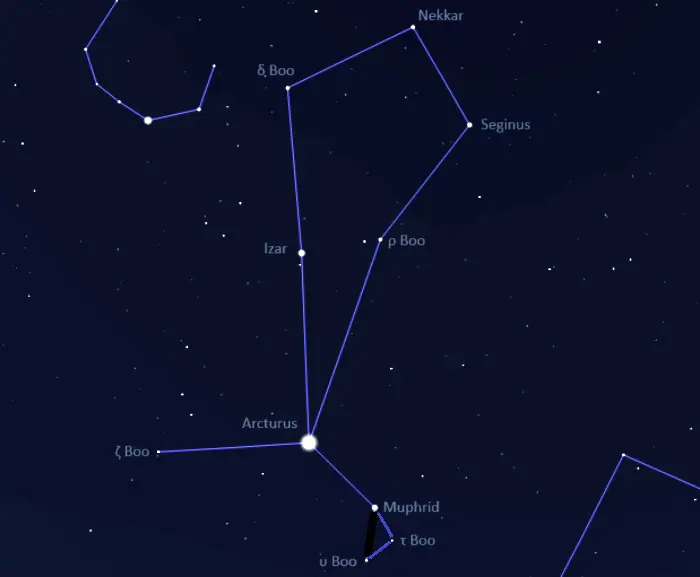
The Kite asterism, image: Stellarium
Name
The name Muphrid (pronunciation: /ˈmjuːfrɪd/) comes from the Arabic mufrid ar-rāmiħ, meaning “the (single) one of the lancer.” The name Al Mufrid al Ramih (“the solitary star of the lancer”) appeared in the 15th century Timurid astronomer Ulugh Beg’s star catalogue. The name was historically also spelled Mufrid and Mufride.
The 13th century Persian astronomer Zakariya al-Qazwini called the star Al Rumh.
The 17th century Egyptian astronomer Al Achsasi al Mouakket listed Eta Boötis as Ramih al Ramih (rumḥ al rāmiḥ) in his Calendarium. The name was later translated into Latin as Lancea Lanceator (“the lance of the lancer”).
The name Muphrid was approved by the International Astronomical Union’s (IAU) Working Group on Star Names (WGSN) on September 12, 2016. It formally applies only to the primary component in the Muphrid star system, Eta Boötis A (WDS J13547+1824Aa).
The star was also traditionally known as Saak, derived from Al Sak (“the shin bone”).
In Chinese astronomy Eta Boötis was known as 右攝提一 (Yòu Niè Dī yī), the First Star of the Right Conductor. Muphrid formed an asterism called the Right Conductor with Tau Boötis and Upsilon Boötis. The asterism was part of the larger Neck mansion, which represented the neck of the Azure Dragon.
Location
Muphrid is very easy to find because it shines at third magnitude and appears near Arcturus, the Bear Keeper. It is the brightest star just west of Arcturus.
Arcturus can be found by following the arc of the Big Dipper’s handle, formed by Alioth, Mizar and Alkaid. The curved line leads first to Arcturus and then to the bright Spica in the constellation Virgo.
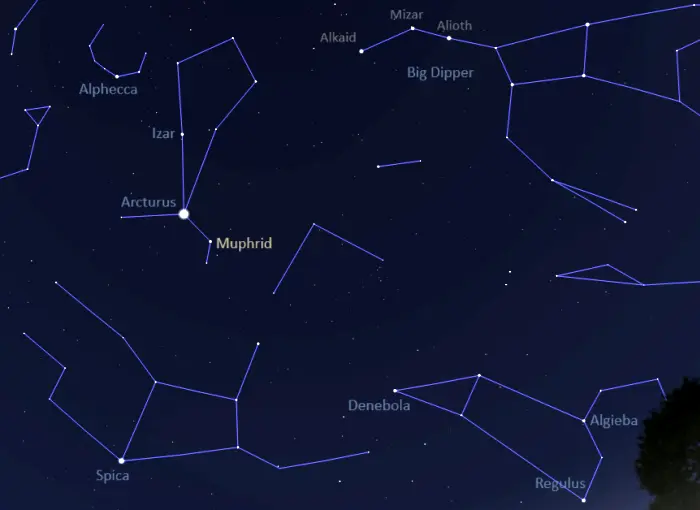
The location of Muphrid (Eta Boötis), image: Stellarium
Constellation
Muphrid is located in the constellation Boötes. It appears on the Herdsman’s left leg. The celestial Herdsman is one of the Greek constellations, catalogued by the Greco-Roman astronomer Claudius Ptolemy in his Almagest in the 2nd century CE. It is the 13th largest constellation in the sky, occupying an area of 907 square degrees.
Boötes is one of the 48 ancient constellations. It was first mentioned by name in Homer’s Odyssey. In Greek mythology, it is associated with the grape farmer Icarius and with Philomenus (Philomelus), son of the goddess Demeter and patron of husbandry and agriculture, who drove the oxen represented by the stars of the Big Dipper (the Plough) in Ursa Major.
Boötes is home to Arcturus, the brightest star in the northern celestial hemisphere and fourth brightest star in the sky (after Sirius, Canopus and Alpha Centauri). Other notable stars in the constellation include the variable yellow giant Nekkar (Beta Boötis), the orange giants Rho Boötis and Upsilon Boötis, the binary systems Epsilon Boötis (Izar), which can be resolved in 3-inch and larger telescopes, Gamma Boötis (Seginus), and Delta Boötis, and the A-type dwarf Xuange (Lambda Boötis), a prototype for a class of stars with unusually low metallicity.
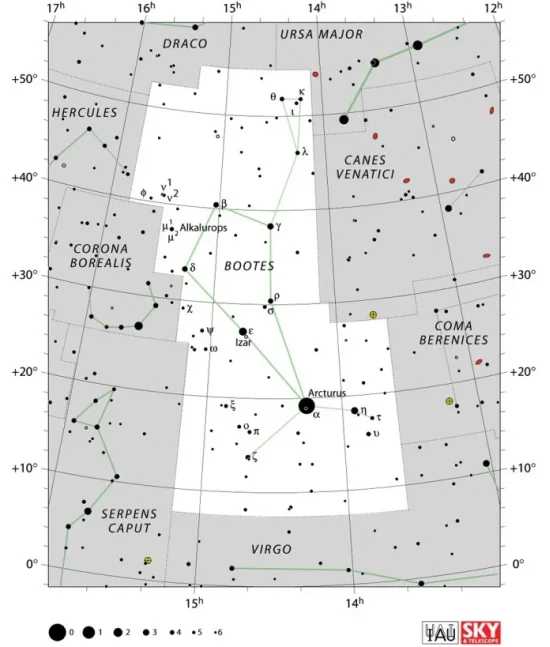
Boötes constellation map by IAU and Sky&Telescope magazine
Relatively bright deep sky objects in Boötes include the globular cluster NGC 5466 (mag. 10.5), the intermediate spiral galaxy NGC 5248 (Caldwell 45), the unbarred spiral galaxies NGC 5676 and NGC 5653, the Seyfert galaxy NGC 5548, and the elliptical galaxy NGC 5886. Boötes also contains the Boötes Void (the Great Nothing), a vast stretch of space that contains very few galaxies for an area its size.
The best time of the year to see the stars and deep sky objects in Boötes is during the month of June, when the constellation appears higher above the horizon in the early evening. The entire constellation is visible from locations north of the latitude 50° S.
The 10 brightest stars in Boötes are Arcturus (Alpha Boo, mag. -0.05), Izar (Epsilon Boo, mag. 2.37), Muphrid (Eta Boo, mag. 2.68), Seginus (Gamma Boo, mag. 3.03), Delta Boötis (mag. 3.482), Nekkar (Beta Boo, mag. 3.488), Rho Boötis (mag. 3.59), Zeta Boötis (mag. 3.78), Theta Boötis (mag. 4.02), and Upsilon Boötis (mag. 4.023).
Muphrid – Eta Boötis
| Spectral class | G0 IV |
| U-B colour index | +0.207 |
| B-V colour index | +0.585 |
| Apparent magnitude | 2.680 |
| Absolute magnitude | 2.41 |
| Distance | 37.2 ± 0.5 light-years (11.4 ± 0.2 parsecs) |
| Parallax | 87.75 ± 1.24 mas |
| Radial velocity | 5.771110 ± 0.007471 km/s |
| Proper motion | RA: -60.95 ± 1.14 mas/yr |
| Dec.: -356.29 ± 0.73 mas/yr | |
| Mass | 1.71 ± 0.05 M☉ |
| Luminosity | 8.89 ± 0.16 L☉ |
| Radius | 2.672 ± 0.028 R☉ |
| Temperature | 6,100 ± 28 K |
| Metallicity | +0.29 ± 0.07 dex |
| Age | 2.7 billion years |
| Rotational velocity | 11.8 km/s |
| Surface gravity | 3.817 ± 0.015 cgs |
| Constellation | Boötes |
| Right ascension | 13h 54m 41.07892s |
| Declination | +18° 23′ 51.7946″ |
| Names and designations | Muphrid, Eta Boötis, η Boo, 8 Boötis, HD 121370, HR 5235, HIP 67927, SAO 100766, BD+19°2725, AG+18 1285, FK5 513, Gl 534, GC 18805, GCRV 8204, LTT 14060, NLTT 35643, PPM 130166, GCTP 3175.00, PLX 3175.00, JP11 2455, NSV 19993, TD1 17144, TIC 367758676, WEB 11935, GALAH 140709001901194, IRC +20267, ASCC 869594, AP J13544106+1823514, SRS 30513, LSPM J1354+1823, RAFGL 4923S, UBV 12376, UBV M 19832, USNO 849, USNO-B1.0 1083-00239773, EXO 1352.3+1838, RAVE J135441.1+182352, IRAS 13522+1838, 2MASS J13544106+1823514, TYC 1470-1157-1, Gaia DR2 1244946371540223872, Gaia DR3 1244946371540479616, BDS 6670, CCDM J13547+1824, IDS 13499+1854, WDS J13547+1824A |